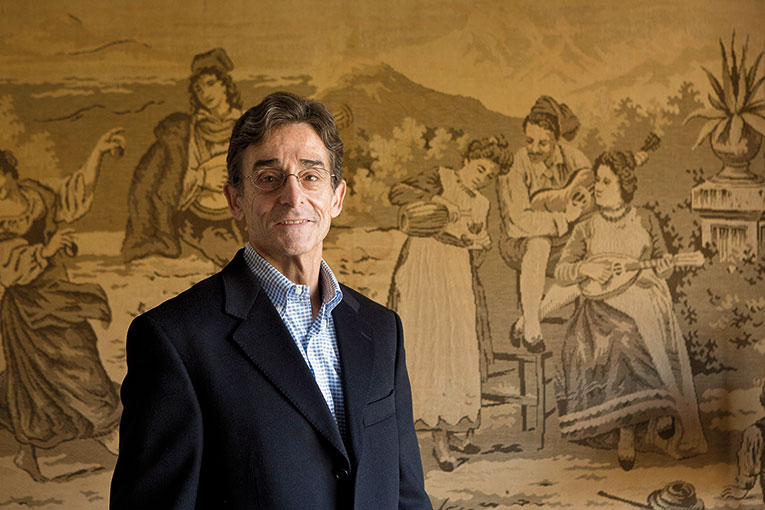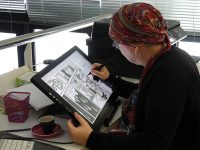Interview with Javier Magriña
«Doctors should make the decisions after taking advice from administrators»
Gynaecologic Oncologist and Surgeon specialised in Robotic Surgery at the Mayo Clinic (Arizona, United States)

Javier Magriña knew he wanted to be a surgeon ever since he could perform his first autopsy during his medical studies in Barcelona. His enthusiasm was fuelled by the support of the Catalan doctor Santiago Dexeus, a family friend, who instilled in him a passion for gynaecology and even found him internships for a few summers at clinics in Paris and London, where he learned cytology and gynaecological pathology. When Javier Magriña finished his studies, his career was already irrevocably oriented towards gynaecology. However, he did not like obstetrics, he wanted to operate. When, through a friend, he learned that the Mayo Clinic allowed a much larger level of expertise in his area than European centres, he did not hesitate to apply for a residency, which brought him to America in 1974. What at first was supposed to be a temporary situation became something more hardwearing when he had the opportunity to study a subspecialty in gynaecologic oncology, which was new at the time. He returned to Barcelona, but he soon realized that his specialisation was not properly valued there. So, it did not take long for him to return to America. An adventure that still continues.
Although he has made a life in America, Javier Magriña never miss the chance to return to Barcelona if his work schedule allows it. We are welcomed in a family house in the most affluent area of the city, during one of those uncomfortable days between holidays in late December. His long stay in the United States has provided him with a different outlook on life, in addition to a curious and subtle accent while speaking. A change of mind-set. He repeatedly insists that the key to efficiency in medicine is subspecialisation. He uses sport metaphors to explain it: «If anyone wants to play professional football, tennis and basketball at the same time, they will never succeed. Even if you only play football, you play in the midfield or as a scorer, you are not changing positions. Even football players are subspecialised. It is exactly the same thing in medicine.»
«When the government gets involved in health, which is what Obama wants to do now, workers become civil servants and lose interest and motivation»
In America, Dr Magriña seems to have found what he always pursued. He tells with a loving enthusiasm the story of the Mayo brothers, the two doctors who founded the clinic where he currently works, as if they were his own ancestors. «They were working men», he says. He seems grateful to the country that has welcomed him and makes no criticism to its healthcare system. On the contrary, he seems dissatisfied with the European model of public health since, in his opinion, it is too dependent on civil servants and that hinders its progress. His story suggests an America where cancer is no longer taboo and issues related to this disease are naturally addressed in the media and in public conversations. He strongly supports robotic surgery, a technology he has contributed to make popular with to his own use of the Da Vinci robot, available at the Mayo Clinic. Like most experts, he insists that more effort should be made on prevention to combat cancer.
What is your opinion regarding the healthcare system in the United States?
It is great, but I know the academic side better, where there is a high level of subspecialisation. For example, we do not have obstetrics in our department. Obstetrics must be separated from gynaecology. Does the same man who operates on a patient need to know about pregnancy? What do these two areas have in common? The patient, who is a woman. But they are completely different fields.
And in terms of healthcare services?
In America, healthcare services are so specialised that our gynaecology department is divided between gynaecologists and surgeons. Gynaecologists do not operate; they only work in the examination room. And when they diagnose a patient who needs an operation, surgeons go into action. There are four subspecialties: Maternal-foetal medicine, Gynaecologic Oncology, Urogynaecology and Reproductive medicine. We are specializing at a high level. Health care in America has this advantage: you will find a guy who just makes you a very specific thing and therefore, your problems can be better solved. This does not mean that we are better, but if I devote myself to playing a sport in a particular position I will do much better than one that has to play in all positions. This is now beginning to happen in Europe too.

Javier Magriña / Ferran Nadeu
The Mayo Clinic is defined as a «non-profit» organisation. The fact that all doctors receive a fixed salary helps to eliminate economic pressure when making decisions about patients. How is this work system noticeable?
The Mayo brothers were sons of an English immigrant who practiced medicine in his clinic in the United States. He sent his two sons to Europe because back then the best surgeons were there (Austrians, Germans, French…). When they returned to the United States, they set up a clinic in a small village called Rochester. They were very successful because they joined the nuns, who treated patients in a very well. As time went on, the Mayo brothers set up a school to transfer what they had learned in Europe. They had to pay both teachers and residents. So, they created a foundation and all the income was placed in a pooled fund. Salaries are paid from this fund. And what remains at the end of the year is reinvested in the institution. This system allows buying new equipment or investing in research. The advantage of this system is that a doctor that performs five hundred surgeries a year and one that performs two hundred get the same salary. Then, why will an operation be performed if it is unnecessary? There are many patients coming to the Mayo Clinic to get a second opinion, to know if they need an operation or not. There is no economic interest.
Do you think research progress made at the Mayo Clinic could be achieved in a public centre?
No, I don’t, because when the government gets involved in health, which is what Obama wants to do now, workers become civil servants and lose interest and motivation. To do research in our centre, we have the money left in the joint fund, which we can access through proper channels. But priority is given to the most interesting studies. There is competitiveness. You have to earn it.
«Among the American population it is very common for someone to tell you that they had a cancer operation many years ago. They talk about it normally, there is no tendency to feel like a victim»
What is your opinion regarding the present situation of the public health system in the Spanish State?
One of the advantages of the Mayo Clinic is that doctors run the centres. The three main leaders are doctors. Administrators are below them. The head of each of the existing committees is a doctor. The secretary is an administrator. Doctors know what patients need. Administrators think about economy. When the Mayo brothers were developing the clinic, they wanted to do research. An administrator said: «For the record, I am completely against it because we will lose money and it will do no good to the clinic». And yet the two Mayo brothers decided to go ahead. Had an administrator been the boss, research would not have been carried out, and a lot of things that have been done in the clinic would have been lost. In the European healthcare system, administrators manage everything. Not only in Spain, also in Italy, for example. Taking the Mayo Clinic as an example of good management, I think doctors should make the decisions after taking advice from administrators.
The fear of cancer is so great that the word itself has become some sort of taboo. Do you also see it that way?
Not in the United States. When I got there, I realised that every patient was told exactly what they had in great detail, while in Spain doctors could not tell patients that they had cancer. And patients are more educated on their condition. We explain what they have, what can happen and the treatment. And if there is more than one treatment, we explain it so patients can take part in the decision making process. I remember a Spanish patient that came here in 1980. She had been diagnosed with cancer but she did not know. Nobody had told her. I sat with her and I explained her as best as I could. She said: «I already knew that, but you have been the only honest person who has told me». She thanked me. Then I realized that patients should be told. Why not? 55% of all gynaecologic cancers are cured. However, there are many other incurable diseases.

Javier Magriña / Ferran Nadeu
Do you think that the media generally treat cancer-related information properly?
In the United States, they do. In fact, among the American population it is very common for someone to tell you that they had a cancer operation many years ago. They talk about it normally, there is no tendency to feel like a victim. Sometimes with more detail than necessary.
Are some tumours more socially stigmatized than others? For example, breast cancer is very hard for women…
Yes, but breast cancer is detected much earlier now than it was when I started working. In addition, we used to always resort to a mastectomy, which is removing the breast, but now we perform lumpectomies too, thus it is very common to preserve the breast. And if the breast has to be removed for whatever reason, plastic surgeons have developed reconstruction techniques. The stigma associated to breast cancer where the breast was supposed to be disfigured for life does no longer exist. There has been a tremendous change.
80% of tumours occur due to environmental causes. Does this indicate that taking measures on prevention is the priority?
Absolutely. For example, the worst gynaecologic cancer that we have is ovarian cancer. If it is detected at Stage 1, the probability that the patient will survive is much greater than if cancer is detected at a higher stage. The earlier the diagnosis, the better. Another example: in breast cancer, the number of patients has been reduced since the BRCA gene was found. Those patients were treated with a prophylactic mastectomy. 90% of cancers can be prevented by using this procedure. If ovaries are also removed, they prevent 60% of ovarian cancer in patients with BRCA genes. This has greatly improved. Then, environmental causes are very important. The HPV (Human papillomavirus), which is sexually transmitted, can cause cancer in women. You give them a vaccine and while preventing infection with the virus we prevent cancer as well.

Javier Magriña / Ferran Nadeu
You work with robotic surgery. How can this technology improve modern medicine?
In surgery, the important thing is not to make an incision, but small holes. The patient recovers sooner and suffers less pain and fewer complications. All studies prove it. Thanks to robotics, you sit in front of the console and instruments follow the movement of your hand. They do not go in the opposite direction as in laparoscopy. Many gynaecologists could not perform laparoscopies because it was vey difficult. We have made a progress in that these gynaecologists that were still operating with incisions now operate using small holes. Patients are the ones who have benefited from it.
In your specialty, Gynaecologic Oncology, it appears to be a very beneficial technology.
Those tools follow your hands, and have three-dimensional vision too. Sitting at the console is like having your head stuck in the belly of the patient because you can zoom the camera to the tissues. You can watch details that get lost in regular surgery. You start seeing microanatomy: lymph nodes, small nerve fibres… In addition, the surgeon is seated, and thus does not suffer much physical fatigue. In a four-hour operation that is very noticeable. The machine does not move or get tired, it does not need to eat or go to the toilet. A person cannot do that. Another advantage is that it eliminates any trembling. Regarding articulation, the instrument remains rigid in laparoscopy. However, the instrument can be bent several times in robotic surgery. The disadvantages are its high cost of purchase and maintenance ($500 a day in the United States). Additionally, the instruments only last for ten uses. If the instrument is worth $2,500, each use costs $250. The cost is very high.
According to one of your articles, the Da Vinci robot used in the clinic to operate is based on a NASA design…
There were people who had to go to outer space to fix in the spaceship at 280,000 kilometres per hour. Every once in a while somebody was lost. Then they thought of setting robotic arms that allowed fixing things on the outer surface of the spaceship without anyone having to actually go outside. NASA developed this system. In 1995, some investors thought that it could be applied to surgery. They thought that it would be best applied in cardiovascular surgery. But when they presented the first Da Vinci robot to heart surgeons, they were not interested and the robot almost disappeared from the market. It was retrieved by urologists, who have to work in an uncomfortable location such as the pelvic floor, so they could use the benefits robotics had to offer. Urologists rescued the Da Vinci robot. And gynaecologists have put it on the forefront.
In your opinion, will robotic surgery eventually prevail?
Yes. Very precise instructions will be created. Now, we are using one robot for different specialties, but soon robots we will have more specific robots designed to work with particular body parts. Now we do five holes when we operate. There will be robots that will allow up to three instruments inside each hole, so we will progressively open less holes. There will be progress.
Are operating rooms where only robots work possible in a few years?
I do not think so. There are certain operations in which robots are not needed. For example, robotic systems are not needed to make a tubal ligation, a cholecystectomy or an appendectomy. Laparoscopy will continue to be used. And, as robotics is more expensive, it will be saved for very specific operations. Robotic and laparoscopic surgeons will be needed. Subspecialisation, again.





